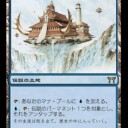神河当時 - 伝説の土地サイクルの優劣性
2020年10月25日 Magic: The GatheringWhat do these decks have in common? Look closely:
(省略)
I don’t know if it counts to say that "none of these decks are Affinity", but I guess that is technically accurate. All of these non-Affinity Standard decks also did well recently, but not all of them are State or Provincial Champions, even if most of them are finalists, at least. Bryn Kenny’s deck, the only one not drawn from a Champs Top 8 link, is especially special because we already looked at it back in Two Tournaments, One Deck, One Card in Particular. The weekend of PT Columbus, Bryn not only picked up his first Pro Points by way of the Columbus Last Chance Qualifier, but, according to the Professional Events Services website, he also fought past 102 opponents to finish in the Top 8 of the $2000 PT Columbus Amateur Challenge with exactly the same deck. Well, not exactly... Between the LCQ and the $2000 PT Columbus Amateur Challenge, Bryn cut Boseiju, Who Shelters All from his sideboard for the fourth Plow Under.
If all you want is a good deck list that doesn’t automatically pack four copies of Aether Vial, Arcbound Ravager, and Disciple of the Vault, all of these decks are tournament proven... but that doesn’t exactly make them unique.
So what ties them together? The above decks casually play cards like:
These lands are for almost all intents and purposes much better than their corresponding basic lands, more so than almost any lands to have seen play since the original dual lands back in Revised. If these cards aren’t "strictly better" than basic lands, they are about as close as R&D is going to get for the forseeable future. When we say that one card is strictly better than another, we mean that for its cost, its size, whatever, one card is empirically superior to another by some specific metric without giving anything else away.
引用元
COMMON GROUND Posted in Feature on November 24, 2004
https://magic.wizards.com/en/articles/archive/feature/common-ground-2004-11-24
当時のスタンダードの「親和でない」デッキに、《永岩城/Eiganjo Castle》などの、『神河物語』の伝説土地サイクルが採用されていることについての考察記事です。
これらの伝説土地は、アンタップインであり、マナを出す上でのデメリットも条件もありません。その点では、基本土地の上位互換のように見えます。
しかし、同じ色と戦う上では、(可能性はそう高くないとはいえ)当時のレジェンドルール「対消滅」で潰れるデメリットを無視できません。
一方で、当時の強力な色対策《沸騰/Boil》に引っかからないという利点もあります。相手の《死者の嘆き、崩老卑/Horobi, Death’s Wail》を軽く倒せるのも大きいです。
こうした一長一短の特徴は、デッキ構築に興味深い選択肢をもたらすので、個人的には悪くないと思います。
ただ、最近のMTGではどうでしょうか。
対消滅ルールは変わってしまいましたし、基本土地を大量に破壊するような色対策はまず作られません。特殊地形対策どころか、土地破壊ですら、希少になりました。
現在のルール・方針であった場合、これらの伝説土地のカードの評価は良くも悪くも、基本土地より少し強い程度、で落ち着くでしょう。
追記
最近では、伝説のクリーチャーが多く収録されるようになりました。その点を考えると、起動型能力の活躍する機会は、当時以上に多いかもしれません。
2021/03/09 追記
日本語訳を見つけました。
共通の地盤――神河物語の伝説の土地の利点(と弱点)の評価
https://web.archive.org/web/20041210092332/http://www.hobbyjapan.co.jp/magic/articles/files/20041126_01.html




コメント